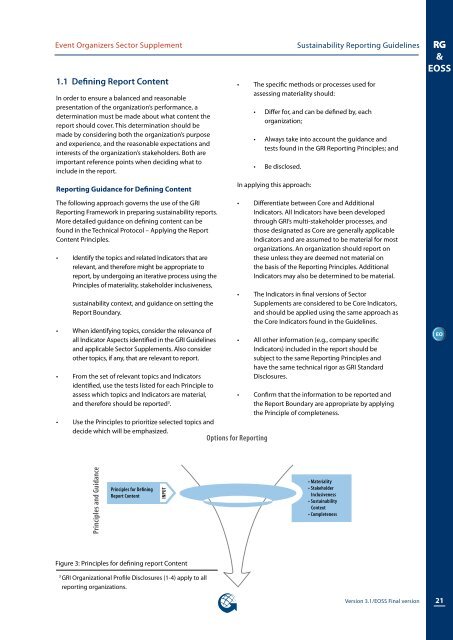Event Organizers Sector Supplement - Global Reporting Initiative
Event Organizers Sector Supplement - Global Reporting Initiative
Event Organizers Sector Supplement - Global Reporting Initiative
You also want an ePaper? Increase the reach of your titles
YUMPU automatically turns print PDFs into web optimized ePapers that Google loves.
<strong>Event</strong> <strong>Organizers</strong> <strong>Sector</strong> <strong>Supplement</strong><br />
1.1 Defining Report Content<br />
In order to ensure a balanced and reasonable<br />
presentation of the organization’s performance, a<br />
determination must be made about what content the<br />
report should cover. This determination should be<br />
made by considering both the organization’s purpose<br />
and experience, and the reasonable expectations and<br />
interests of the organization’s stakeholders. Both are<br />
important reference points when deciding what to<br />
include in the report.<br />
<strong>Reporting</strong> Guidance for Defining Content<br />
Sustainability <strong>Reporting</strong> Guidelines<br />
• The specific methods or processes used for<br />
assessing materiality should:<br />
• Differ for, and can be defined by, each<br />
organization;<br />
• Always take into account the guidance and<br />
tests found in the GRI <strong>Reporting</strong> Principles; and<br />
• Be disclosed.<br />
In applying this approach:<br />
RG<br />
&<br />
EOSS<br />
The following approach governs the use of the GRI<br />
<strong>Reporting</strong> Framework in preparing sustainability reports.<br />
More detailed guidance on defining content can be<br />
found in the Technical Protocol – Applying the Report<br />
Content Principles.<br />
• Identify the topics and related Indicators that are<br />
relevant, and therefore might be appropriate to<br />
report, by undergoing an iterative process using the<br />
Principles of materiality, stakeholder inclusiveness,<br />
sustainability context, and guidance on setting the<br />
Report Boundary.<br />
• When identifying topics, consider the relevance of<br />
all Indicator Aspects identified in the GRI Guidelines<br />
and applicable <strong>Sector</strong> <strong>Supplement</strong>s. Also consider<br />
other topics, if any, that are relevant to report.<br />
• From the set of relevant topics and Indicators<br />
identified, use the tests listed for each Principle to<br />
assess which topics and Indicators are material,<br />
and therefore should be reported 3 .<br />
• Use the Principles to prioritize selected topics and<br />
decide which will be emphasized.<br />
Options for <strong>Reporting</strong><br />
• Differentiate between Core and Additional<br />
Indicators. All Indicators have been developed<br />
through GRI’s multi-stakeholder processes, and<br />
those designated as Core are generally applicable<br />
Indicators and are assumed to be material for most<br />
organizations. An organization should report on<br />
these unless they are deemed not material on<br />
the basis of the <strong>Reporting</strong> Principles. Additional<br />
Indicators may also be determined to be material.<br />
• The Indicators in final versions of <strong>Sector</strong><br />
<strong>Supplement</strong>s are considered to be Core Indicators,<br />
and should be applied using the same approach as<br />
the Core Indicators found in the Guidelines.<br />
• All other information (e.g., company specific<br />
Indicators) included in the report should be<br />
subject to the same <strong>Reporting</strong> Principles and<br />
have the same technical rigor as GRI Standard<br />
Disclosures.<br />
• Confirm that the information to be reported and<br />
the Report Boundary are appropriate by applying<br />
the Principle of completeness.<br />
EO<br />
Principles and Guidance<br />
Principles for Defining<br />
Report Content<br />
INPUT<br />
• Materiality<br />
• Stakeholder<br />
Inclusiveness<br />
• Sustainability<br />
Context<br />
• Completeness<br />
Figure 3: Principles for defining report Content<br />
3<br />
GRI <br />
Organizational Profile Disclosures (1-4) apply to all<br />
reporting organizations.<br />
Version 3.1/EOSS Final version<br />
21

















